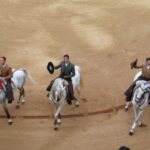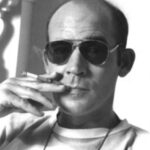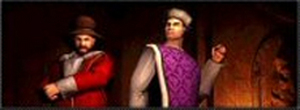“The Dangerous Summer” by Ernest Hemingway is about a summer of bull fighting in Spain.
“Ernest Miller Hemingway was born at eight o’clock in the morning on July 21, 1899 in Oak Park, Illinois” (Welcome 1). In the nearly sixty two years of his life that followed he forged a literary reputation unsurpassed in the twentieth century and created a mythological hero in himself that captivated (and at times confounded) not only serious literary critics but the average man as well…in a word, he was a star” (Welcome 1).
Hemingway received his formal schooling in the Oak Park public school system” where he enjoyed working on the high school newspaper called the Trapeze (Welcome 2). He “graduated in the spring of 1917 and instead of going to college the following fall like his parents expected, he took a job as a cub reporter for the Kansas City Star” where he learned “some stylistic lessons that would later influence his fiction” (Welcome 2).
“When Hemingway turned eighteen he tried to enlist in the army, but was deferred because of poor vision” (Welcome 2). “When he heard the Red Cross was taking volunteers as ambulance drivers he quickly signed up. He was accepted in December of 1917, left his job at the paper in April of 1918, and sailed for Europe in May” (Welcome 2).
Due to the help he gave wounded soldiers after he was wounded, he was awarded the Italian Silver Star for Valor (Welcome 2). “Hemingway’s wounding along the Piave River in Italy and his subsequent recovery at a hospital in Milan, including the relationship with his nurse Agnes von Kurowsky, all inspired his great novel A Farewell to Arms” (Welcome 3).
Hemingway could not muster interest in anything when he returned home after the war (Welcome 3). For a time he questioned his role as a war hero and often exaggerated his war stories to please his audience (Welcome 3). His last speaking engagement caught the attention of Harriet Connable who hired Hemingway to be her son’s tutor in Toronto while she and her husband spent their summer in Florida (Welcome 3). He worked for the Toronto Star Weekly while he was there (Welcome 4). “Hemingway wrote for the Star Weekly even after moving to Chicago in the fall of 1920” (Welcome 4). That’s when he met and married Hadley Richardson (Welcome 4). After their marriage, Hemingway accepted a job with the Toronto Daily Star as its European Correspondent and the couple moved to Paris where Hemingway’s writing career began to take off (Welcome 4).
The Hemingways had a son together before divorcing in 1927 (Welcome 5). He married Pauline Pfeiffer later that year (Welcome 6). The couple had two sons together, the last of Hemingway’s children (Welcome 7).
From 1925 to 1929 Hemingway produced some of the most important works of 20th century fiction, including the landmark short story collection In Our Time (1925) which contained ‘The Big Two-Headed River’ (Welcome 5). In 1926 he came out with his first true novel, The Sun Also Rises” (Welcome 5). He followed that book with Men Without Women in 1927, A Farewell to Arms in 1929 and Death in the Afternoon, a nonfiction book, in 1932 (Welcome 5).
In March 1937 Hemingway traveled to Spain to cover the Spanish Civil War” (Welcome 9). He met a young writer named Martha Gellhorn whom he married four years later after divorcing Pauline (Welcome 9). While he was having his affair with Martha, Hemingway wrote For Whom the Bell Tolls which was published in 1940 (Welcome 9).
Although the book sold well it would be the last one published in ten years (Welcome 9). During this time Hemingway “worked on what would become the heavily edited and posthumously published novels Islands in the Stream and The Garden of Eden (Welcome 10).
In 1944 Hemingway decided to go to Europe to cover the war (Welcome 10). He was wounded and hospitalized and when Martha visited him she criticized him for driving drunk (Welcome 10). Her reaction “triggered the beginning of the end of their marriage” (Welcome 10). During this time Hemingway met and fell in love with Mary Welsh (Welcome 10). His marriage to Martha ended and one with Mary, his last one, began (Welcome 11).
Hemingway returned to America in March of 1946 with plans to write a great novel about the war, but it never materialized” (Welcome 11). “The only book length work he would produce about the war was Across the River and Into the Trees” (Welcome 11). It received a critical reception that stung Hemingway (Welcome 12). He was “determined to regain his former stature as the world’s preeminent novelist” (Welcome 12). He “began work on a story of an old man and a great fish” (Welcome 12). The book was easy for Hemingway to write and in September of 1952 The Old Man and the Sea appeared in Life magazine, “selling over 5 million copies in a flash” (Welcome 12).
In January of 1954 Hemingway and Mary were in a plane crash while visiting Africa (Welcome 12). “The crash had injured Hemingway more than most would know” (Welcome 12). “His injuries cut short his life in a slow and painful way” (Welcome 13). Despite his ailments, Hemingway and Mary traveled on to Venice one last time and then headed back to Cuba. On October 28, 1954 Hemingway won the Nobel Peace Prize for Literature” (Welcome 13).
“After 1954 Hemingway battled deteriorating health which often kept him from working” (Welcome 13).
In 1959 Life magazine contracted with Hemingway to write a short article about the series of mano y mano bullfights between Antonio Ordonez and Luis Miguel Dominguin, two of Spain’s finest matadors” (Welcome 13). The story quickly grew to about 120,000 words that Hemingway could not edit into short form (Welcome 13). He enlisted the help of A. E. Hotchner and together the two cut it down to 65,000 words (Welcome 13). “Despite reservations about the article’s length the magazine published the article as ‘The Dangerous Summer’ in three installments in 1960. This was the last work that Hemingway would see published in his lifetime” (Welcome 13).
Hemingway began having trouble writing and began showing signs of physical deterioration during the summer of his 60th year (Welcome 13). “During this time Hemingway was also working on his memoirs which would be published in 1964 as A Moveable Feast” (Welcome 13). “By this time Hemingway had left Cuba, departing in July of 1960, and had taken up residence in Ketchum, Idaho where he and Mary had already purchased a home in April of 1959” (Welcome 14).
In the fall of 1960 Hemingway flew to Rochester, Minnesota and was admitted to the Mayo Clinic … for help with serious depression” (Welcome 14). Hemingway spent the first half of 1961 fighting his depression and paranoia” (Welcome 14). “On the morning of July 2, 1961” Hemingway “shot himself in the head. It was little more than two weeks until his 62nd birthday” (Welcome 14).
Other works by Hemingway include Winner Takes Nothing (1933) and Green Hills of Africa (1935).
“That Dangerous Summer” is an account of two of Spain’s most famous bullfighters, Antonio Ordonez and Luis Miguel Dominguin. Hemingway and his wife Mary spent the summer of 1953 following the two around Europe as they went from bullfight to bullfight.
The book focused on the individual fights as well as Antonio and Luis Miguel. Hemingway went into great detail to describe the way they each fought and used the terms that go along with each part of the fight. These terms were explained in a glossary that followed the story.
Hemingway went into great detail in describing the bullfights. I could picture everything that was happening as Hemingway mentioned it. In some cases this was not a good point of the book for me. Although I enjoyed reading about the fights I did not enjoy the details of the accidents and injuries.
During the story Antonio was wounded twice and Luis Miguel three times, once almost gravely. I held my breath after each injury, waiting to find out if the matadors, the bullfighters, were going to be all right or not.
As I read the story I was aware that Hemingway had a closer friendship with Antonio than with Luis Miguel. Although he and Luis were friends it was obvious that Hemingway took Antonio under his wing more.
The story was filled with a lot of action; some quieter moments such as get togethers and the trips to the individual fights; and special moments of kinship between Hemingway and both matadors. What made the story warm-hearted was that Antonio and Luis Miguel were brothers-in-law. Antonio was married to Luis Miguel’s sister. When the two fought the bulls together Hemingway made sure he mentioned how it made Carmen, Antonio’s wife and Luis Miguel’s sister, feel.
Added bonuses to the book were some pictures of the matadors, bulls, and family and friends. They made the characters in the book, including Hemingway himself, seem more real.
I enjoyed the story and learning about a sport I never understood. Hemingway helped me appreciate the art of bullfighting, not as much as the matadors and the true fans do, but more than I did. I came to respect the sport and all involved in it when I read how the matadors treat the bulls. To them, it is not simply torturing and killing an animal, as I thought. It is ending the bull’s life in a highly respectable way.
Reference:
- Welcome to The Hemingway Resource Center.; www.lostgeneration.com/hembio/html




